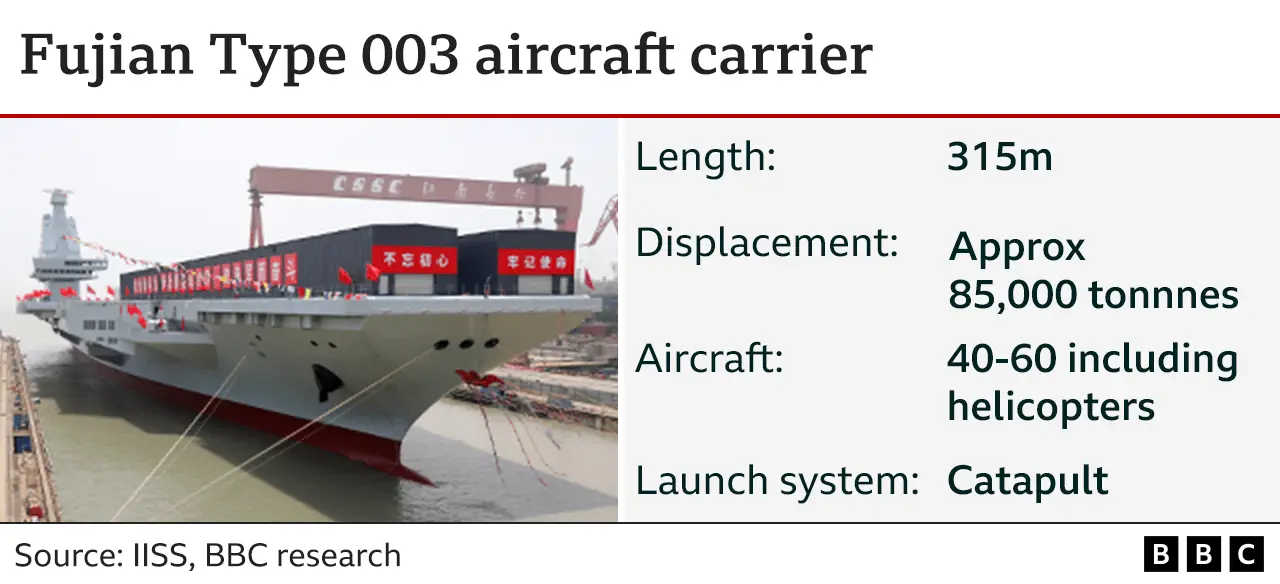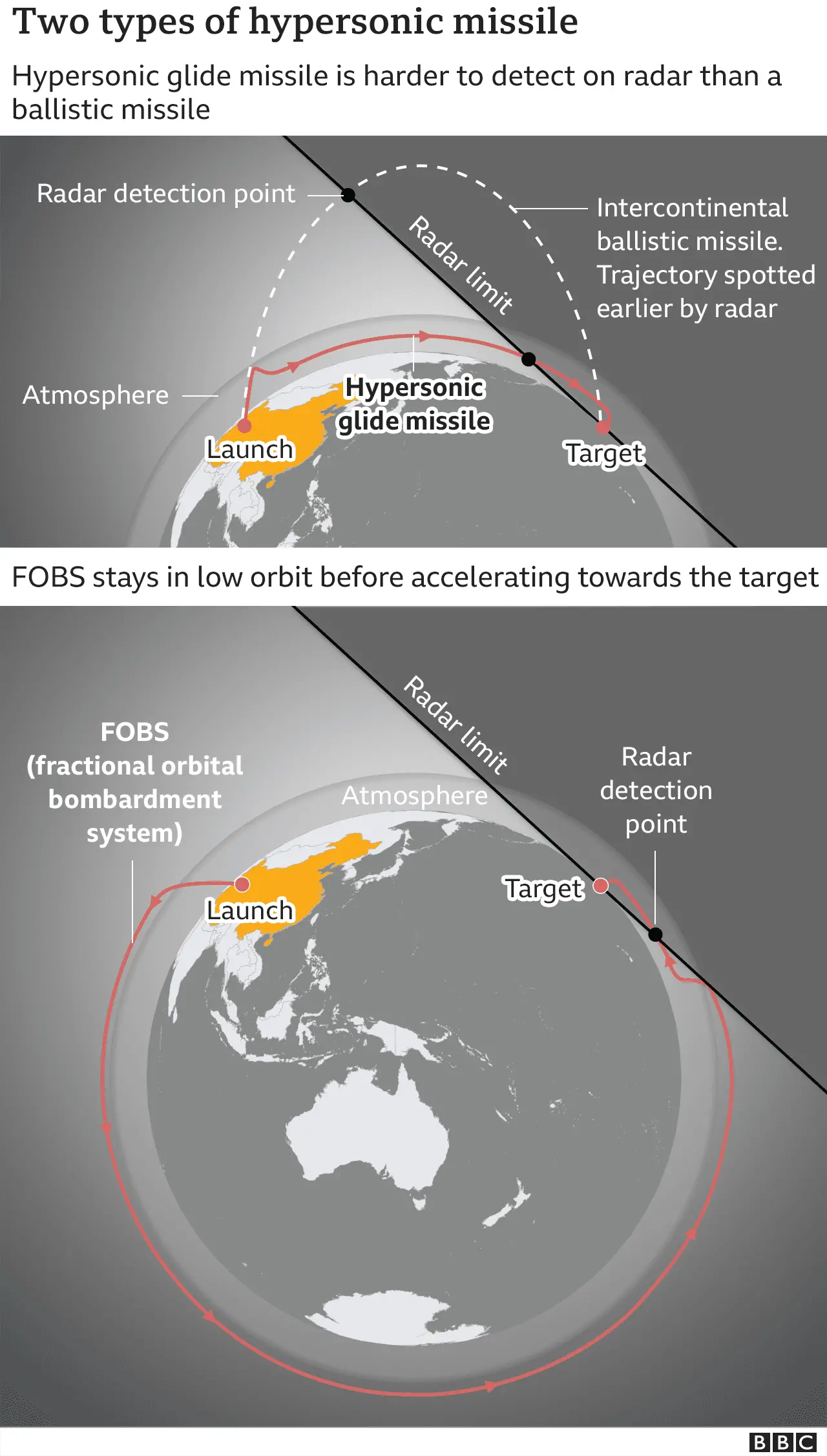Why China could win the new global arms race
 BBC
BBCChina is building up its armed forces at a rapid pace, most recently with the launch of a new aircraft carrier.
Many Western observers now believe a profound shift in the global balance of military power is under way.
President Xi Jinping has ordered China's armed forces to modernise by 2035. They should, he says, become a "world-class" military power, capable of "fighting and winning wars" by 2049.
The world's largest, but not most powerful, navy
The Fujian, a type 003 aircraft carrier, was launched in Shanghai in June and is the most advanced warship ever built in China.
The vessel is China's third aircraft carrier and, unlike the other two, it was designed by Chinese engineers.

Military professionals say the Fujian's electromagnetic aircraft launch system is a significant advance for China's navy, allowing aircraft to be deployed more quickly, and enabling the vessel to carry heavier planes.
It is unclear how long it will take to test and fully outfit the Fujian and when it will enter service, but it will join a fleet which overtook the US to become the largest navy in the world in 2014.
Whilst a simple comparison of ship numbers leaves out many factors which determine a navy's capabilities, analysts say an examination of the trends is useful.

For now, the US maintains a strong lead in many naval capabilities, with 11 aircraft carriers to China's three, and more nuclear-powered submarines, cruisers and destroyers - or larger warships.
But China is expected to expand its navy much further.
The US Navy predicts that between 2020 and 2040, the total number of Chinese navy ships will increase by nearly 40%.
Former People's Liberation Army Senior Colonel Zhou Bo, of Tsinghua University in Beijing, says he believes China's naval expansion is "critically important" in countering the sea-based threats which it faces.
In particular, he says: "The most outstanding problem we face is what we perceive to be American provocation in China's waters."
Spending big
China has been criticised by some international experts for a "lack of transparency" over how much it spends on defence, and an "inconsistent reporting of figures".
Beijing does publish official spending data, but Western estimates of China's financial support for its armed forces are often significantly higher.
It is widely believed that China currently spends more on its armed forces than any country except the US.

The growth of China's military budget has outpaced its overall economic growth for at least a decade, according to the Center for Strategic and International Studies in Washington.
Boosting the nuclear stockpile
In November, the US Department of Defense predicted that China was set to quadruple its nuclear stockpile by the end of the current decade. China, it said, "likely intends to have at least 1,000 warheads by 2030".
Chinese state media called the claim "wild and biased speculation", adding that nuclear forces were kept at a "minimum level".
However, experts at the Stockholm International Peace Research Institute, who publish annual assessments of global stockpiles, say China has been increasing the number of its warheads over recent years.


China is still a long way short of the US stockpile of 5,550 warheads, but its nuclear build-up is being seen as one of the biggest threats to Western military supremacy.
"China's nuclear weapons are the most important issue," according to Veerle Nouwens, of the Royal United Services institute in London.
"There is a huge lack of trust on both sides and dialogue is nowhere near the level needed. There are big risks and the off-ramps are difficult to see."
Hypersonic future
Hypersonic missiles travel at more than five times the speed of sound.
They are not as fast as intercontinental ballistic missiles, but they are so difficult to detect in flight that they may render some air defences useless.
"The Chinese understand that they are a long way behind, so they are trying to make big breakthroughs to leap-frog other powers," according to Dr Zeno Leoni, of King's College London.
"Developing hypersonic missiles is one of the ways they're trying to do this."


China has denied testing hypersonic missiles, but Western experts believe that two rocket launches last summer indicate that its military is well on the way to acquiring them.
It's unclear exactly what systems China may be developing. There are two main types:
- Hypersonic glide missiles stay within the Earth's atmosphere
- Fractional orbital bombardment systems (FOBS) fly in low orbit before accelerating towards a target
It is possible that China may have succeeded in combining the two systems, firing a hypersonic missile from an FOBS manoeuvrable spacecraft.


Dr Leoni says that while hypersonic missiles may not - on their own - be a game-changer, they will make some targets highly vulnerable to attack.
"Hypersonic missiles make aircraft carriers in particular much more difficult to defend," he says.
However, he also suggests that that the threat from Chinese hypersonic missiles may have been overstated by some Western officials, who are keen to make as strong a case as possible for the financing of military space technology.
"The threat is real. Yet, it is possible that this is being exaggerated."
Artificial intelligence and cyber-attacks
China is now fully committed to developing "intelligentised" warfare, or future military methods based on disruptive technologies - especially artificial intelligence, according to the US Department of Defense.
China's Academy of Military Science has been given a mandate to make sure that this happens, through "civil-military fusion", in other words joining up Chinese private sector technology companies with the country's defence industries.
Reports suggest that China may already be using artificial intelligence in military robotics and missile guidance systems, as well as unmanned aerial vehicles and unmanned naval vessels.
China has already conducted large-scale cyber-operations abroad, according to a recent expert assessment.
In July the UK, US and EU accused China of carrying out a major cyber-attack targeting Microsoft Exchange servers.
It is believed that the attack affected at least 30,000 organisations globally and aimed to enable large-scale espionage, including the acquisition of personal information and intellectual property.
Uncertain future
Is China moving away from non-confrontation towards a more threatening stance?
For now, the Chinese approach is still "win without fighting", says Dr Leoni, although he adds that it could change this strategy some time in the future.
"Becoming a fully modernised naval power could be one tipping point."
But Senior Colonel Zhou insists that Western fears are unfounded.
"China has no intention of policing the world, unlike the United States," he says. "Even if China becomes much stronger one day, it will maintain its basic policies."
China has not fought a war since 1979, when it went into battle with Vietnam, so much of its military capabilities are completely untested.
Many in both the West and in China will hope it stays that way.
Graphics by Sandra Rodriguez Chillida, Joy Roxas and Sean Willmott
